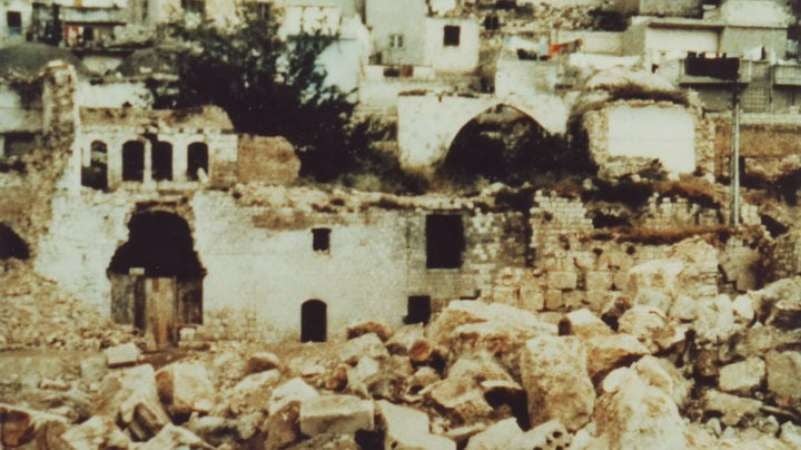By Owais Al-Emadi and Anwar Al-Hamwi
Since Hafez al-Assad came to power in 1970, the main features of the security policy used to consolidate his rule in Syria was to exclude all opposition voices and create a loyal militia as one of the main pillars of his rule. Hama province was one of the first Syrian governorates to suffer the effects of this policy built on the exclusion of the majority population in Syria and entrenchment of securitized, sectarian rule.
The policies of the Ba’ath party clashed with many customs and beliefs of the majority population in Syria. These policies were exemplified by changing the article stipulating that the president of Syria should be a Sunni Muslim and other practices such as banning the headscarf, often violently removing it of the heads of women and underage girls with officials mocking them as “women parachutes.” Such practices caused a strong reaction among the faithful and the first public protest started to materialize in Hama governorate, through popular uprisings and, at first, small-scale demonstrations which gradually expanded to the rest of the Syrian governorates. This show of popular dissent led Hafez al-Assad to enact draconian and brutal measures to stabilize his security policy, which continues to terrorize the Syrian people for decades. He chose Hama governorate to make it an example and implement a high-level repressive plan to stop the uprisings in all Syrian governorates. Hama governorate was an important hub of protests against his dictatorial rule, it was less populated than the rest of the rebellious cities such as Aleppo and Homs, and, importantly, it is an inner governorate with no land borders with any neighbouring countries. It was possible to keep the brutal repression away from the international media and avoid regional and international pressure.
On this day, 39 years ago, the attack began.
First displacement (1982):
On February 2, 1982, Hama woke up to the sound of the tanks surrounding it. The massacre led by Assad’s security forces, spearheaded by the Brigades of Defence Battalions of Rifaat Assad, began and lasted for twenty consecutive days. Thousands of civilians were killed, thousands were arrested, thousands more were displaced never to return to their homes, till this day. The massacre was to serve as a clear message of the sectarian regime to all the people of Syria, not only to the residents of the city of Hama. Displacement used to remove disobedient civilians from Hama was to be a blueprint for the later displacement of millions of Syrians.

Ruins in Hama after the 1982 massacre – Wikipedia.
The harassment, prosecution and provocation of civilians by Assad’s security forces and people belonging to the ruling Baath Party continued since Hafez al-Assad took power in 1970, culminating in the final bloody attack which killed scores of people in the artillery and aerial attacks on the city and the massacres that took place after the army stormed the city on 2 February 1982. There are no accurate statistics for the number of dead, but the estimates by the Syrian Human Rights Committee speak of between 30 and 40 thousand killed, most of them women, children and the elderly. These estimations indicate that approximately one hundred thousand residents were displaced from the city that had a population about 300,000 people at that time. People mostly fled in secret, as the regime’s security forces did not leave safe passages for the exit of civilians, but rather killed the largest possible number of civilians and demolished many neighbourhoods in the city with the people still inside their homes. This displacement took place over a whole month and was followed by secret escapes of some wanted persons and their families in the months following the massacre.
The displaced went to three main destinations: Hama countryside and neighbouring cities, neighbouring Arab countries, such as Jordan and Iraq, and foreign countries, mainly Europe and America.
Testimonies of witnesses and evidence documented by activists speak of unimaginable cruelty, which led to the displacement and dispersal of a large number of families. Many people lost their family members as they fled terrified, just to save their lives.
Witnesses of that time speak of between 300-500 children sheltering in Khalid bin Al-Walid mosque in Homs without their families. Some families eventually located their children, but many remained orphans.
Entire families died either under the rubble of demolished homes due to bombing or in direct liquidations. Many families lost their children during the displacement. These families never got to know if their children died or got lost and remained in orphanages. Hafez Al-Assad regime deliberately demolished certain neighbourhoods (such as the al-Kilani neighbourhood), and never allowed them to be rebuilt.

AL-Kilania neighbourhood before and after the 1982 massacre.
Harassment and shootings in the streets continued until the beginning of 1983, when it culminated with the arrest of thousands of innocent people and their incarceration in the notorious prisons of Palmyra and Mezzeh. Large number of people were detained there who were never involved in any political activity opposing the Baath regime, but the accusation was that they had relatives wanted by security forces. These search and arrest campaigns by Assad’s security forces extended to the Hamwi countryside, as many villages such as Helfaya, Kirnaz, Taybet Al-Imam, Qalaat Al-Madiq and others were subjected to search and terror campaigns that led to the flight of a large number of people. Many were forced to flee and leave their families because of suspicions or malicious accusations which could mean death without any judicial or legal process.
Second displacement (2011):
As days and years passed, Hafez Al-Assad’s regime continued ruling Syria through repression and terror of its people, every opponent was immediately accused of terrorism, masses forced to chant: “Forever, Hafez Al-Assad.” However, the day that every oppressed Syrian waited for came, Hafez Al-Assad died and his security system handed over power to his son Bashar. The son continued his father’s policy of suppressing freedoms and arresting opponents, claiming that his ruling policy would be development and modernization. Very soon these claims would prove to be nothing but lies, with the regime entrenching sectarian rule and repression. The people’s revolution for freedom and dignity in 2011 was a natural result of decades of injustice and corruption extended from the father to the son.
As in most of the governorates of Syria, Hama governorate has seen systematic displacement since 2011. Regime’s operations aiming to displaced people from the governorate began after the peaceful demonstrations in the city of Hama, which were witnessed by large numbers of journalists and ambassadors of some major countries. Immediately after the protests, the regime’s security forces stormed the city, arresting scores of peaceful activists. This prompted many others to leave their homes and flee to avoid arrest operations. The pursuit operations continued in all areas of Hama governorate, while the systematic shelling of civilian areas in the Hamwi countryside led to the displacement of most of its inhabitants. Some villages were razed to the ground, especially in the eastern, western and northern countryside of Hama, while the displacement operations in the villages of the southern countryside were somewhat less severe. Even those who initially stayed in areas subjected to search and arrest campaigns of the security forces, ultimately had to flee to avoid forced recruitment of the youth who were taken to compulsory service and made to participate in the killing, looting and destruction of cities and villages of Syria, themselves becoming part of the forces causing successive waves of displacement that are continuing until now.

The destruction in Kafr Zita, Hama, 2016 © SMART News Agency
Most of the people of Hama Governorate, who were displaced from their original areas, have gone through several successive migrations over the past years, and many of them have turned into refugees by leaving north towards Turkey, Lebanon or Jordan. The majority of those who migrated to Turkey settled in Hatay province in southern Turkey, and the rest was distributed to the rest of the provinces. Others went to Europe and the rest of the world. The largest number of Hama residents remained as internally displaced people in Idlib governorate and in the northern and western countryside of Aleppo governorate.
There are no accurate statistics with numbers of refugees and internally displaced people from Hama governorate. Those who left the city and were displaced from it for fear of arrest and disappearance fled in secret as individuals and families over a period of nine years, often without reporting anywhere. At the same time, the random bombing and shelling deliberately targeting civilians in the Hamwi countryside, which came under control of the opposition forces soon after the revolution, pushed people to flee over the last eight years to other liberated areas further north or to Turkey and European countries. According to the estimations of local organizations and associations, 10 to 15% of the Hama city’s population, or approximately 120,000 people, has been displaced. As for the Hamwi countryside, the “Syria Response Team” made estimates of the numbers of displaced from 2011 until the final displacement due to the latest onslaught by the regime and Russian forces, through the forced displacement agreements. According to these estimates, there were about 350,000 displaced from the northwestern countryside, about 250,000 displaced from the northern countryside, including entire villages, and about 150,000 displaced persons from the eastern countryside. These numbers are in addition to the southern countryside, which also suffered from forced displacement, but in fewer numbers, that coincided with the displacement of the northern countryside of Homs.
The entire Hama governorate is now under the control of the Assad regime forces, as a result of violent military operations and through forced displacement agreements in the southern countryside in parallel with the displacement of the northern Homs countryside, which displaced most of the native population.
Dozens of reports have been written describing the state of the regime’s strategy of displacement that surpassed by multiple times the Palestinian displacement. Displaced people of Hama first had to sleep in the streets, then they moved to live in tents or old camps. Some even had to put blankets and plastic bags instead of doors and windows of unfinished buildings, a family often living in only one room. This is how the majority of the displaced live.
Most of them suffer poverty, lack of services, scarcity of job opportunities, in a complete collapse of the economic and health system, in addition to the shrinking number of relief organizations operating in the North. Many are still exposed to systematic bombing by the Assad regime and its allies.

A displaced Syrian child sits in front of his family’s flooded tent in Dalhamiya camp, eastern Lebanon, January 15, 2019 (UNHCR)
The most prominent manifestation of the misery of internal displacement is the multiple displacements. People flee once and then they are made to flee again under bombardment. They go to another region, and the pattern repeats, they have to flee again. This suffering extended from the countryside of Hama to the southern countryside of Idlib, which in turn came under attack and people had to flee further north, close to the border with Turkey.
On the other hand, the regime, through its “Reconciliation Office” and some security figures, under supervision and instructions of the Russian military, tried to call people to return to the areas of its control with promises of reconciliation. These proved a complete failure because of the lack of sincerity of the regime, which used these returns to exert revenge. Not even minimal security exists for the displaced to return to these areas. There is no hope at present for the return of these displaced people to their original areas, with the presence of Assad and his repressive regime.
Post scriptum
The 39 years which passed since 1982 taught us that the Assad regime, from the father to the son, intends to rule Syria with a stony hand. The power of this regime is consolidated in the blood of the Syrians, starting from Hama to every inch of the country, displacing thousands of Hamawies and millions of Syrians. However, we continue to daily dream of return to our homeland and our cities, and we will do so one day. Our return will be safe, and free of bombardment, arrests, torture and oppression. This is what prompts us as Syrians to join hands and convey our voice to the whole world to support our movement and our demands in the face of injustice. For we are Syria, Syria that will one day flourish, renewed by the returning Syrians.
Cover photo: A picture of the neighborhoods of Hama, after it was demolished in the 1982 massacre.



